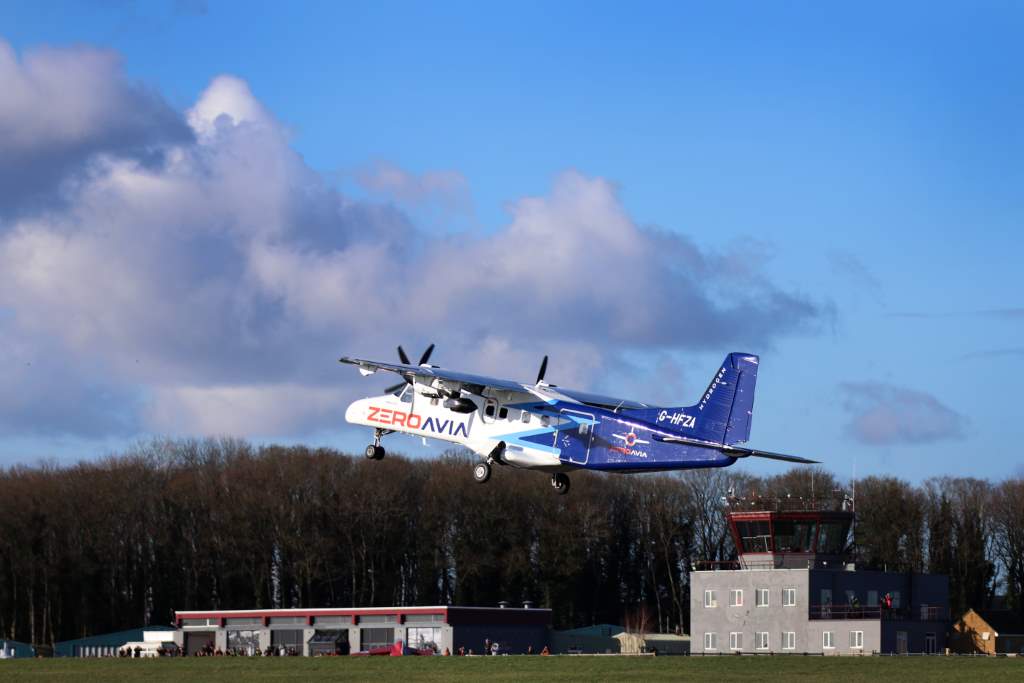Hydrogen-electric aircraft celebrates first flight
Zero-emission flight took a step forward yesterday with ZeroAvia flying what is thought to be largest aircraft in the world to be powered by a hydrogen-electric engine.
The zero-emission aviation firm took to the skies for the maiden flight of its 19-seat Dornier 228 testbed aircraft, retrofitted with a full-size prototype hydrogen-electric powertrain on the left wing of the aircraft.
The flight took place from the company's R&D facility at Cotswold Airport in Gloucestershire, UK, and lasted 10 minutes. At 13.35 yesterday the aircraft completed taxi, take-off, a full pattern circuit, and landing. The landmark flight forms part of the HyFlyer II project, a major R&D programme backed by the UK government's flagship ATI Programme, which targets development of a 600kW powertrain to support 9-19 seat aircraft worldwide with zero-emission flight.
The twin-engine aircraft was retrofitted to incorporate ZeroAvia's hydrogen-electric engine on its left wing, which then operated alongside a single Honeywell TPE-331 stock engine on the right. In this testing configuration, the hydrogen-electric powertrain comprises two fuel cell stacks, with lithium-ion battery packs providing peak power support during take-off and adding additional redundancy for safe testing. In this testbed configuration, hydrogen tanks and fuel cell power generation systems were housed inside the cabin. In a commercial configuration, external storage would be used and the seats restored.

All systems performed as expected. This is the largest ZeroAvia engine tested to date, and places the company on the direct path to a certifiable configuration to be finalized and submitted for certification in 2023, with this programme also serving as key to unlocking speedy technology development for larger aircraft. ZeroAvia's 2-5 MW powertrain programme, already underway, will scale the clean engine technology for up to 90-seat aircraft, with further expansion into narrowbody aircraft demonstrators over the next decade.
Of note, this flight test campaign is being conducted under a full Part 21 flight permit with the UK CAA, which is a much more stringent set of requirements compared to the E-Conditions framework ZeroAvia used for its 6-seat prototype test flights in the prior years.
ZeroAvia will now work towards its certifiable configuration in order to deliver commercial routes using the technology by 2025. The Dornier 228 will conduct a series of test flights from Kemble and later demonstration flights from other airports. Almost exactly two years ago, ZeroAvia conducted the first of more than 30 flights of a six-seat Piper Malibu aircraft using a 250kW hydrogen-electric powertrain.
Val Miftakhov, Founder and CEO of ZeroAvia said: "This is a major moment, not just for ZeroAvia, but for the aviation industry as a whole, as it shows that true zero-emission commercial flight is only a few years away. The first flight of our 19-seat aircraft shows just how scalable our technology is and highlights the rapid progress of zero-emission propulsion. This is only the beginning - we are building the future of sustainable, zero climate impact aviation. Our approach is the best solution to accelerate clean aviation at scale. Congratulations to everyone on our team and all of our partners and stakeholders for the collective effort that brought us to this monumental day in history."
This latest achievement follows ZeroAvia's previous world-first milestones, starting with 6-seat prototype flights of a Piper M-Class airframe in 2019, and the world's first commercial-scale 6-seater hydrogen-electric powered flight in September 2020. The 2020 prototype was a part of the HyFlyer I programme in the UK. Unlike the previous tech demonstrator programme, ZeroAvia's 600kW engine being developed under HyFlyer II is a commercial-intent programme.
The hydrogen-electric powertrain on board was fuelled using compressed gaseous hydrogen produced with an on-site electrolyser.
To enable hydrogen production on site, ZeroAvia and HyFlyer II partner, the European Marine Energy Centre (EMEC), have delivered and operated the Hydrogen Airport Refuelling Ecosystem (HARE), a microcosm of what infrastructure will look like in terms of green hydrogen production, storage, refuelling and fuel cell powered flight. The system's electrolyser capacity was doubled earlier this year from its initial design for the latest project.
ZeroAvia's HyFlyer II programme to develop its ZA-600 hydrogen-electric engine and retrofit the Dornier 228 is being delivered in partnership with EMEC and Aeristech and is supported by the UK government through the ATI Programme and the Department for Business, Energy Industrial Strategy, Innovate UK and Aerospace Technology Institute. Val Miftakhov is also a member of the UK government's Jet Zero Council.
The historic first flight follows significant commercial momentum for ZeroAvia in recent months, including an engine order from American Airlines, a partnership agreement with OEM Textron Aviation and infrastructure partnerships with airports including Rotterdam, Edmonton International and AGS Airports. With 1,500 engines on pre-order, partnerships with seven aircraft manufacturers, and a number of fuel and airport partnerships, ZeroAvia is well positioned to lead the industry's transformation to a clean future.













